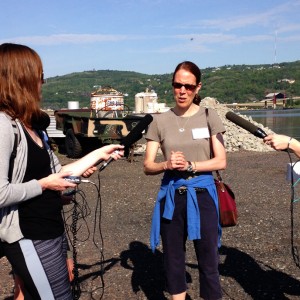Federal Water Tap, July 13: Lake Erie Algae Bloom Could Be Second Worst on Record
The Rundown
NOAA scientists update their algae forecast for Lake Erie. California representatives introduce more water legislation while a massive engineering project spawns another environmental review and state regulators approve a reservoir plan to save salmon. NASA studies carbon storage in wetlands. The Obama administration reports on climate actions. Several EPA advisory committees will meet.
“While we are forecasting a severe bloom, much of the lake will be fine most of the time. The bloom will develop from west to east in the Lake Erie Western Basin, beginning this month. It is important to note that these effects will vary with winds, and will peak in September.” — Richard Stumpf, NOAA’s ecological forecasting applied research lead at the National Centers for Coastal Ocean Science, speaking about the Lake Erie algae forecast.
By the Numbers
$US 1.9 billion: Dollars spent by the Bureau of Reclamation between 1993 and 2014 on three watershed programs in California’s Central Valley. The money went toward ecosystem restoration, scientific studies, and feasibility assessments. (Government Accountability Office)
$US 25,000: Fine levied against the Navajo Tribal Utility Authority for discharging pollutants above permitted levels into Black Creek, a water body on Navajo land in northeastern Arizona. (U.S. Environmental Protection Agency)
Reports and Studies
Lake Erie Algae
Heavy rains in June in Ohio’s Maumee River Basin swept loads of nutrients into the shallow western basin of Lake Erie, prompting researchers to increase the projected severity of the lake’s annual summer algae bloom. The bloom could be the second worst on record.
Wetland Carbon Storage
NASA and the U.S. Geological Survey are beginning to collect data for a study of the amount of carbon that is stored in coastal wetlands. The National Blue Carbon Monitoring System will fill a data gap and help the United States quantify its greenhouse gas emissions.
California’s Water Choke Point
The Bureau of Reclamation submitted a revised environmental review of a massive engineering project proposed for California’s Sacramento-San Joaquin Delta. In April, Gov. Jerry Brown split the project in two. He scaled back the habitat restoration component and offered a redesign of the intake structure for the twin tunnels that will move water underneath the delta, to farms and cities in the Central Valley, Bay Area, and Southern California. Public comments are being accepted through August 31.
Climate Preparation
The Obama administration released a report on the actions taken to date in response to recommendations from a climate change task force. Established by executive order in November 2013, the task force comprised governors, mayors, and tribal officials. Included are programs to invest in green infrastructure that will retain rainfall; to expand the use of water management tools by local governments; and to collect the data that will assist such planning efforts.
News Briefs
Water Recycling Bill
Rep. Doris Matsui (D-CA) introduced a bill that is designed to allocate federal dollars more quickly to water recycling projects in states suffering from drought. Matsui has a particular project in mind: a $US 180 million facility proposed for her home region of Sacramento that would provide up to 50,000 acre-feet of recycled water per year.
Drought Bill
Rep. Jared Huffman (D-CA), after two weeks of public review, introduced his drought bill in Congress. The 149-page bill is the latest — and broadest — entrant in a field of drought bills. Huffman claims that nearly 1,000 Californians made comments on his bill, which resulted in several changes before it was submitted. One such addition: a $US 2,000 tax credit for homeowners to install tanks that store rainwater.
California Drought Update
State regulators approved a revised federal reservoir management plan that is designed to protect endangered salmon in the Sacramento River. The State Water Resources Control Board signed off on the Bureau of Reclamation’s plan to reduce water releases from Shasta Lake, the state’s largest reservoir, in order to conserve cold water. The cold water will be needed later this summer to keep the river’s temperature from rising so high that it cooks the salmon.
On the Radar
House Fracking Hearing
On July 15, a House Natural Resources subcommittee will discuss hydraulic fracturing on federal public lands. Last month, a U.S. district judge temporarily prevented new Bureau of Land Management rules for fracking on federal land from going into effect. The court-ordered one-month stay expires on July 22.
EPA Advisory Committee Meeting
On July 30-31, a committee of mayors, county commissioners, city managers and other such officials that consults with the EPA on matters important to local governments will discuss water policy. The meeting, held at EPA headquarters in Washington, is open to the public.
EPA Science Committee Meeting
The panel of experts that advises the EPA on science questions will hold a public teleconference on August 3 to discuss the agency’s list of contaminants in drinking water that might require regulation. The contaminant candidate list was published in February, and must be updated every five years.
Federal Water Tap is a weekly digest spotting trends in U.S. government water policy. To get more water news, follow Circle of Blue on Twitter and sign up for our newsletter.
Brett writes about agriculture, energy, infrastructure, and the politics and economics of water in the United States. He also writes the Federal Water Tap, Circle of Blue’s weekly digest of U.S. government water news. He is the winner of two Society of Environmental Journalists reporting awards, one of the top honors in American environmental journalism: first place for explanatory reporting for a series on septic system pollution in the United States(2016) and third place for beat reporting in a small market (2014). He received the Sierra Club’s Distinguished Service Award in 2018. Brett lives in Seattle, where he hikes the mountains and bakes pies. Contact Brett Walton





Leave a Reply
Want to join the discussion?Feel free to contribute!